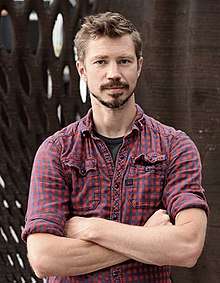Joris Laarman
Joris Laarman (born October 24, 1979) is a Dutch designer, artist and entrepreneur best known for his experimental designs inspired by emerging technologies.
Joris Laarman | |
|---|---|
 Joris Laarman in 2017 | |
| Born | October 24, 1979 (age 40) Borculo, Netherlands |
| Occupation | Dutch artist |
Biography
Laarman was born in Borculo,[1] Netherlands. He graduated Cum Laude from the Design Academy Eindhoven in 2003. Laarman first received international recognition for his "Heatwave radiator" produced by the Dutch design brand Droog and later manufactured by Jaga Climate Systems.[2] Heatwave radiator is now on public display at the High Museum of Art in Atlanta, Georgia, USA.
In 2004, Laarman together with his partner Anita Star, founded Joris Laarman Lab in Amsterdam, Netherlands. The lab collaborates with craftsmen, scientists and engineers and the possibilities of emerging technologies as CNC systems, 3D printing, robotics or simulation software.
Laarman's designs are in the permanent collections and exhibitions in such institutions as MoMA, New York City;[2] V&A, London ; Centre Pompidou, Paris. The Bonechair and its prototype were recently added as the closing works of the 20th century collection of the Rijksmuseum, Amsterdam.
He has contributed to articles and seminars for Domus Magazine and has lectured at the Architectural Association School of Architecture, London, the Gerrit Rietveld Academy, Amsterdam and the Design Academy Eindhoven.
In 2013, the Lab collaborated with Greenpeace installing a time capsule at the bottom of the arctic sea for the Save the Arctic campaign.[3]
Selected works
Awards
- 2011: Wall Street Journal, Innovator of the year Award[6]
- 2008: International Elle Decoration, Designer of the year
- 2006: Red Dot Design Award
- 2004: Wallpaper magazine, Young designer of the year
- 2004: The International Furniture Fair, IMM, Interior Innovation Award
- 2004: Red Dot Design Award
References
- Bagley, Christopher (March 2008). "Good Bones". W.
- Hartvig, Nicolai (1 May 2012). "Dutch Wunderkind Joris Laarman Applies Cutting-Edge Mathematics to Industrial Design". Art+Auction. Retrieved 2014-01-23.
- Wilson, Jess (7 April 2013). "The Making of an Arctic Time Capsule". Greenpeace International. Retrieved 2014-01-23.
- Khemsurov, Monica (10 March 2010). "The Future's So Bright…". T: The New York Times Style Magazine.
- Lasky, Julie (16 January 2013). "The Beauty of Bacteria". The New York Times.
- Vanderbilt, Tom (October 28, 2011). "Design of the Digital Age". The Wall Street Journal]].
External links
- Official website
- Friedman Benda's website
- Centre Georges Pompidou, Paris, Online collection http://www.centrepompidou.fr/cpv/rechercher.action
- Museum of Modern Art, New York, Online collection http://www.moma.org/collection/artist.php?artist_id=33034